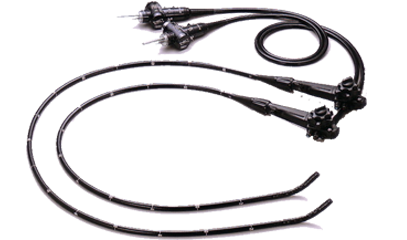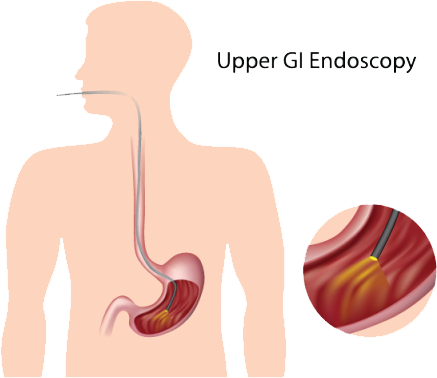What is upper Gastrointestinal (GI) Endoscopy?
Upper GI endoscopy is a procedure in which, an endoscope a flexible long tube with attached camera at end, is passed till upper GI tract by a specialist gastroenterologist to see the inner lining.
What is an Endoscope?
Endoscope is long flexible tube-like device with a lighting on the end. Camera placed at the end of the tube transmits the image of GI tract lining to a "TV" screen in magnified manner to the examiner for visualisation.

Where should you get done UGI endoscopy?
This procedure should be done at a licensed facility by trained endoscopist, usually a gastroenterologist in assistance with trained endoscopy staff.
What is Upper GI Tract?
Upper GI tract usually include Esophagus (Food pipe), Stomach and Duodenum(Initial part of small intestine).
When do doctor advice for UGI endoscopy?
Doctor advise UGI endoscopy to diagnosed and treat symptomps pertaining to upper GI tract.

It can be useful in finding cause of
- Persistent heartburn
- Nausea and vomiting
- Leeding
- Upper abdominal pain
- Uifficulty in swallowing
- Unexplained weight loss
- Chronic diarrhea
It can be useful in finding cause of
- GERD (Gastroesophageal Reflux Disease)
- Peptic Ulcers
- Cancer of Upper GI Tract
- Obstruction in Upper GI Tract
- Swelling or Inflammation
Doctor can advice UGI scopy to treat:
- Bleeding from ulcers or esophageal varices (Dilated Veins)
- Dilate the Strictures
- Remove foreign body, including coin, ring or fishbone etc..
- Remove polyps or growths
- To place feeding tubes or metal stents
How to prepare for an upper GI endoscopy?
First talk with your Doctor / Endoscopist
- About your medical history and complaints.
- Current medication including blood thinner, antidiabetic or antihypertensive.
- Allergies or Drug reactions.
- Any other useful information.
The endoscopist want your stomach empty during the examination, so you are instructed to fast before the test, usually after midnight if the procedure is planned for next morning. In case, if it is scheduled for later in the day, breakfast or light meal is allowed.
The endoscopist want your stomach empty during the examination, so you are instructed to fast before the test, usually after midnight if the procedure is planned for next morning. In case, if it is scheduled for later in the day, breakfast or light meal is allowed.
For safety purpose, patient underwent procedure under anesthesia, should not drive for 24 hours and should be cautious at workplace as sedative used during procedure amy take some time to wear off its effect. So its advisable to make plan for getting a ride home after procedure.
Consent
Your doctor will explain about the procedure and its risks & benefits and after that as with all medical procedures, you will be asked to sign a consent form that certifies that you understand that.
Normally, diagnostic endoscopy is very safe. There are very few complications that can occur like perforation and bleeding, but not limited to it. However, perforations usually occur when the area being examined is diseased and stricturous. Also, bleeding can occur with certain procedures and in certain group especially taking blood thinners, which is why those drugs should be stopped before the procedure.
Sedation
For a routine endoscopy, local anesthesia to throat can suffice. It is usually given through spray or liquid and blunts gag reflex so help patient to swallow the tube. But it has bitter taste and may cause numbness for short time in throat.
In some patients, sedation can given by intravenous injection in the examination room immediately before the test, if required. There are many sedatives and relaxants available for this purpose and most of these are safe and effective, however they require a period of recovery after their administration. During sedation, patient vital is monitored with small clipped device to finger.
Usual protocol is to give “conscious sedation” here you are slightly sedated to make you cooperative during procedure rather than knocking you down completely. Advantage being extreme cooperation and relief from anxiety during procedure, there are few disadvantages also. It takes some time after procedure for recovery and precludes patients for driving or any strenuous activity for a period. There are chances of adverse reaction as well as risk of aspiration during procedure if stomach is not completely empty.
How Endoscopy is done?
Usualy, patient is aksed to lie down on left lateral position with head rested on pillow and chin is slight downward. Mouthpiece is kept through oral aperture and to prevent injury to instrument and to protect teeth. If procedure is to be done under anesthesia, then anesthetist will introduce anesthesia at this point to keep patient in Consious sedated state or else local anesthesia is provided through spray or liquid form before lying down.
The endoscope is introduced through mouth gag and patient is asked to swallow the tube. This is most difficult part as normal gag reflex causes discomfort to patient and prevent entry of endoscope into esophagus easily. At this point examining doctor and assistant will encourage patient repeatedly. Once endoscope is passed from this area, rest of the examination is usually comfortable. Endoscope is usually passed from esophagus to stomach and upto second part of duodenum which is proximal most small intestine. The endoscope insufflates stomach and duodenum with air to make better visualisation. This entire process is captured by a small camera mounted on the endoscope which sends video images to monitor.
During the procedure, endoscopist may perform :
- Acquision of tissues
- Any required intervention like stoppage of bleeding or opening of stricture
- Usual diagnostic procedure may take upto 10 to 15 minutes, however duration is dependent upon finding and it will take more in case of any intervention.
What should I expect after an upper GI endoscopy?
After an upper GI endoscopy, patient can be asked to stay at the recovery room or outpatient center for 1 to 2 hours post procedure, so the effect of sedative can wear off and it is preferable to rest for a day at home.
Patient may feel bloating or nausea for a short time after the procedure and sore throat for a day or two, however they usually recover and patient can start normal diet once swallowing returns to normal.
After the procedure, you—or a friend or family member who is with you if you’re still groggy—will receive instructions on how to care for yourself when you are home. You should follow all instructions.
Some results from an upper GI endoscopy are available right away. Your doctor will share these results with you or, if you choose, with your friend or family member. A pathologist will examine the samples of tissue, cells, or fluid that were taken to help make a diagnosis. Biopsy results take a few days or longer to come back. The pathologist will send a report to your health care professional to discuss with you.